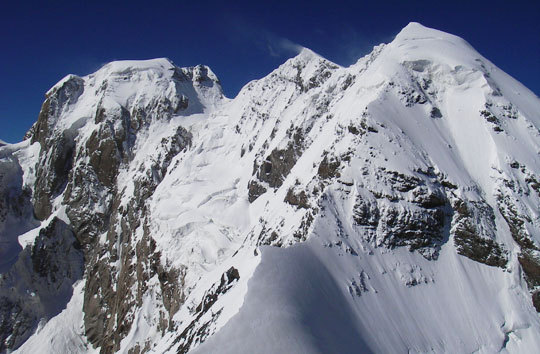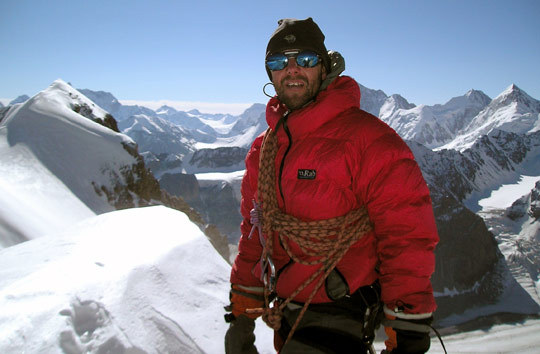
Byeliy (aka Grand Poohbah, 5697m), on left, from the north. This well-defended unclimbed peak lies in the central region of the Western Kokshaal-too on the border of Kyrghyzstan and China. To the right is Peak 5611m. [Photo] Stuart Howard
The eastern (Dankova) and western (Kizil Asker; see the September 17 NewsWire regarding this peak’s recently climbed east face) sectors of the Western Kokshaal-too have been explored by a number of (non-CIS) climbing parties. Since a French-German team traveled to the Dankova region in 1996 and an Anglo-American-German party to the Kizil Asker area in 1997, several recent teams have been investigating the little known central section.
The Western Kokshaal-too forms a relatively remote part of the Tien Shan situated on the Kyrghyzstan-China border. Since the first non-CIS visitors, exploration of this compact area of dramatic peaks has been dominated by Pat Littlejohn and his International School of Mountaineering expeditions. In 2001, a splinter group from one of Littlejohn’s expeditions traveled east to the valley leading up to the Malitskovo Glacier and climbed a 4850-meter peak east of the entrance. Littlejohn was back in 2006, establishing a base camp below the Navlikin Glacier to the east, from where he hoped to attempt the first ascent of Peak Byeliy (aka Grand Poohbah, 5697m). Byeliy has only seen one serious attempt: in 2000 Jerry Dodrill, Mike Libecki, Doug and Jed Workman traveled to the Chinese side of the range and climbed 600 meters up the southwest ridge before stopped by a vicious lightning storm close to the summit. In 2005 the New Zealand-based team of Paul Knott, Grant Piper and Graham Rowbotham hoped to climb it from the Fersmana Glacier east of the Malitskovo but could see no safe line on each of the northeast, east or southern flanks.
In 2006 Littlejohn’s team tried to reach the unclimbed Peak 5611m immediately north of Byeliy but were stopped by heavy snowfall. Other members climbed peaks lower down the Malitskovo and made attempts on Peaks 4995m and 4975m. On the first they reached a forepeak but were stopped by the dangerously corniced connecting ridge, while on the latter they were turned back at ca. 4900m due to the threat of avalanche.
In July-August 2007 British climbers Stuart Howard and Dave Swinburne reached the area via the usual route from Naryn, hoping to climb peaks towards the head of the Malitskovo. Extensive daytime sunshine and nighttime temperatures that rarely fell below freezing meant snow conditions were very poor, but the pair managed to make first ascents of Peak 4975m and Peak 5055m. Both these peaks are marked on Martin Gamache’s American Alpine Club map (Alpine Mapping Guild, 2005), with 5055m to the southwest of 4975m. GPS readings on the summit gave 5100m for Peak 4975 and 5061m for Peak 5055. Both peaks provided simple PD-grade ascents. The pair then turned to Peak 4995m and found more interesting climbing up to AD as far as the summit ridge. Above, the final section of unstable slush was considered too unsafe to attempt. Some days were then spent on the Navlikin but their hopes of attempting a peak north of 5611m were dashed by fresh snowfall.
Howard and Swinburne note that a team of South African guides was also due to be active in this range over the summer, and at the time of writing, Littlejohn is back in-situ. Due to alpine guiding commitments, September is the chosen month for ISM expeditions but is, in any case, generally considered the best month to climb in this area due to more stable weather, lower temperatures and firmer snow conditions. Howard and Swinburne, judging by their own experiences, would also advocate September as the best time to visit the range.

Dave Swinburne on the summit of Peak 5005 (GPS reading of 5061m) after the first ascent. Behind lie innumerable alpine peaks that form part of the Western Kokshaal-too, straddling the border of Kyghyzstan and China. [Photo] Stuart Howard